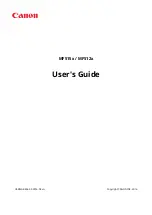
164
Chapter 10 Printer Maintenance
Print a Nozzle Check
Print a Nozzle Check
Introduction
The Nozzle Check print fires each nozzle individually in a manner that allows
clogged nozzles to be easily identified by a visual inspection of this special print. The
Nozzle Check print consists of the following elements:
■
Print Identification - Océ Arizona 250GT Nozzle Check Version and Océ Logo
■
Solid Rectangle - All nozzles are fired simultaneously to exercise them and this
results in a solid rectangle 2.125"x 6.75" (5.4cmx17cm)
■
Print Head Identification - Each printhead is printed in the same order as its
position in the carriage. They are numbered from 1 to 8.
■
Even or Odd Row Identification - Each color has two printheads. One
printhead of a color prints the odd rows and the other prints the even rows.
■
Different Drop Sizes - Each nozzle is fired at five different drop sizes, resulting
in 5 columns of data. Small tick marks are added to the four corners of the
5-column block of data.
■
Individual Nozzles Fired - Each nozzle is fired multiple times. Clogged nozzles
can be easily identified because the 5 mm (7/32") line associated with the clogged
nozzle will be missing from the image. This is often referred to as "nozzle
dropout".
Purpose
The Nozzle Check is used to verify the condition of the nozzles. Clogged nozzles
(nozzle dropouts) can cause banding. Perform printhead maintenance or swab a
printhead to unplug clogged nozzles.
When to do
Print a Nozzle Check after performing printhead maintenance or when
troubleshooting banding problems caused by nozzle dropouts.
Before you begin
The Nozzle Check has been designed to fit on a piece of media that is 36" (91.5 cm)
and is 2.125" (5.4 cm) wide. Since you are likely to print more than one when you
diagnose nozzle problems, make sure your media is wide enough.
Ink must be at the operating temperature of at least 40 degrees Centigrade (140
degrees Fahrenheit) before you print a nozzle check. The Job Control module of the
User Interface displays the ink temperature. If the temperature is low, activate the ink
heater by clicking its control button and then monitor the temperature display.
Содержание Arizona 250 GT
Страница 1: ...Arizona 250 GT Oc User manual User Manual Revision D...
Страница 6: ...6 Table of Contents...
Страница 7: ...7 Chapter 1 Introduction...
Страница 16: ...16 Chapter 1 Introduction Product Compliance...
Страница 17: ...17 Chapter 2 Product Overview...
Страница 21: ...21 Chapter 3 Safety Information...
Страница 45: ...45 Chapter 4 How to Navigate the User Interface...
Страница 47: ...47 Operator Interface Hardware Illustration 33 33 Vacuum System Hardware 34 34 Carriage Area Hardware...
Страница 51: ...51 Operator Interface Hardware Thermal fluid heater Purge pump Purge valve Printheads jetting...
Страница 70: ...70 Chapter 4 How to Navigate the User Interface Installation and Upgrade Module...
Страница 71: ...71 Chapter 5 How to Operate the Arizona 250 GT...
Страница 96: ...96 Chapter 5 How to Operate the Arizona 250 GT Underlay Board to Reduce Artifacts...
Страница 97: ...97 Chapter 6 How to Operate the Roll Media Option...
Страница 122: ...122 Chapter 6 How to Operate the Roll Media Option How to Determine Media Advance Correction...
Страница 123: ...123 Chapter 7 How to Use the Static Suppression Upgrade Kit...
Страница 127: ...127 Chapter 8 Ink System Management...
Страница 134: ...134 Chapter 8 Ink System Management How to Change Ink Bags...
Страница 135: ...135 Chapter 9 Error Handling and Troubleshooting...
Страница 139: ...139 Chapter 10 Printer Maintenance...
Страница 172: ...172 Chapter 10 Printer Maintenance How to Clean the Rubber Capstan...
Страница 173: ...173 Appendix A Application Information...
Страница 176: ...176 Appendix A Application Information Application Resources on the Web Site...















































